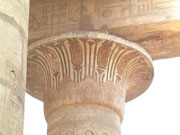TOUR NEWS -
MICHAEL'S TRIP TO SIWA OASIS AND BAHARIYA OASIS DECEMBER 2008
MICHAEL'S TRIP TO SIWA OASIS AND BAHARIYA OASIS DECEMBER 2008
In December I had an opportunity to travel out to some of the Oases in preparation for the upcoming Western Desert Oasis Tour which we are running in February and March 2009. The aim was to have a look at the hotel options and consider day excursions for the new trip.
I headed from Cairo to Siwa Oasis by bus - the trip takes you NW out of Cairo and avoids Alexandria by using a new road which connects to the Mediterranean shore near El Alamein. The trip across this stretch of desert takes you through flat, open country before you reach the sea. We proceeded to Mersa Matruh, the main settlement along this stretch of coast and then headed inland to Siwa Oasis, passing quite close to the Libyan border to the west. This flat open desert was once crossed by Alexander the Great on his way to visit the oracle of Zeus Ammon at Siwa. The appearance of the oasis and the descent into the depression is a wonderful relief!
I stayed in the Siwa Paradise Hotel, which is a very pleasant complex about 200 m from the centre of town. It was very pleasant to walk into town and watch a spectacular sunset from a restaurant in the old city. The following morning I returned to the Old City (the Shali) to explore its fascinating winding streets. One the medieval town, few people live in the crumbling ruins, but the place still resonates with a spirit of the past.
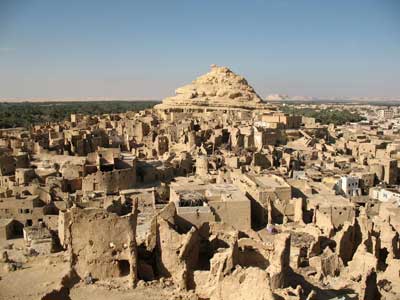 |
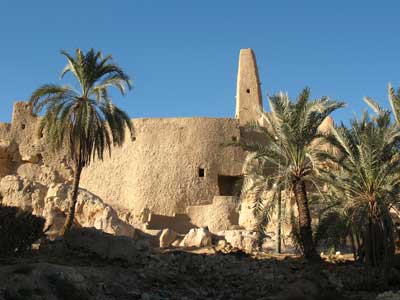 |
The old city of Siwa (the Shali) |
The ruins of Aghurmi, site of the oracle |
In the afternoon I went to see the so-called 'Pool of Cleopatra' a hot spring that bubbles up naturally from the artesian basin. The afternoon was then spent at Aghurmi village, one of the most ancient sites of habitation in the oasis. This is the location of the temple of Zeus Ammon where Alexander consulted the famous oracle and was told that he was the son of God. The temple is well preserved, as is the medieval mosque minaret which towers over the site. The walk back to the hotel is enchanting as you pass through beautiful palm gardens.
In Siwa I also visited the dramatically named Gebel Mawta 'Hill of the Dead' the location for the main cemetery of the Oasis. The hill, which rises out of the palm gardens, contains stunning painted tombs of the Late Period and Ptolemaic Period, and was used by traders and noblemen who lived in this remote location.
A highlight of the Oasis trip was, without question, the day excursion into the Great Sand Sea by 4-wheel drive. We started by exploring the western edge of the Oasis where we found numerous fossil beds and whole areas of coral and deep deposits of shells. We also saw rock art from more recent human habitation, and most fascinating was a visit to a meteor impact site with fragments of extra-terrestrial debris scattered all around! We headed into the deep desert, leaving all sign of growing things behind. The dunes are absolutely stunning (some up to 30 m high), and we crossed through a towering landscape of wind fashioned hills. In front of us the great expanse of the open desert, coupled with the absolute silence, was remarkable. The afternoon ended with a relaxing soak in a hot thermal spa in the middle of the desert at Bir Wahed.
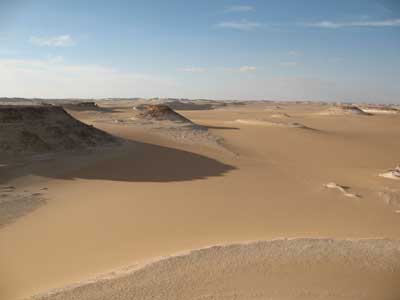 |
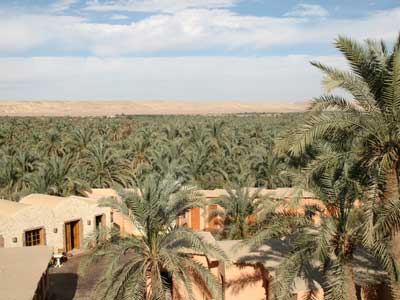 |
View over the Great Sand Sea |
The gardens of Bahariya Oasis |
I left Siwa Oasis and then headed across the open desert in a 4-wheel drive. On the way to Bahariya Oasis we stopped at Nuwamisa Oasis, a real 'Hollywood' style Oasis pool in the desert surrounded by a few palm trees. The landscape is stark and beautiful here.
Bahariya Oasis is a much larger depression than Siwa with a huge expanse of palm gardens. Being closer to the Nile, SW of Cairo, it has been more closely linked with the civilisation of pharaonic Egypt. I stayed in a pleasant hotel near the edge of the gardens.
In Bahariya I explored the fascinating antiquities of the region. In the morning I wandered through the palm gardens and explored the old town of Bawiti with its winding alleys - people still live a simple life here! I also visited the local museum with its collection of the recently discovered 'Golden Mummies' from the Ptolemaic Period. I also saw the interesting remains of the Ain Muftella temple and the ruins of the temple of the deified King Alexander the Great. A highlight of Bahariya is to explore the fascinating painted tombs of the local officials.
These are just a few of the splendid experiences on the Western Desert tour which will also include a visit to Farafra, Dakhleh and Kharga Oases. The program will conclude with an optional extension to the program - a 4-wheel drive trip into the deep desert to visit the Gilf Kebir and the Gebel Uweinat near the Libyan border. The region is famous for its stunning desert landscapes and fascinating Neolithic rock art.
Michael Birrell
